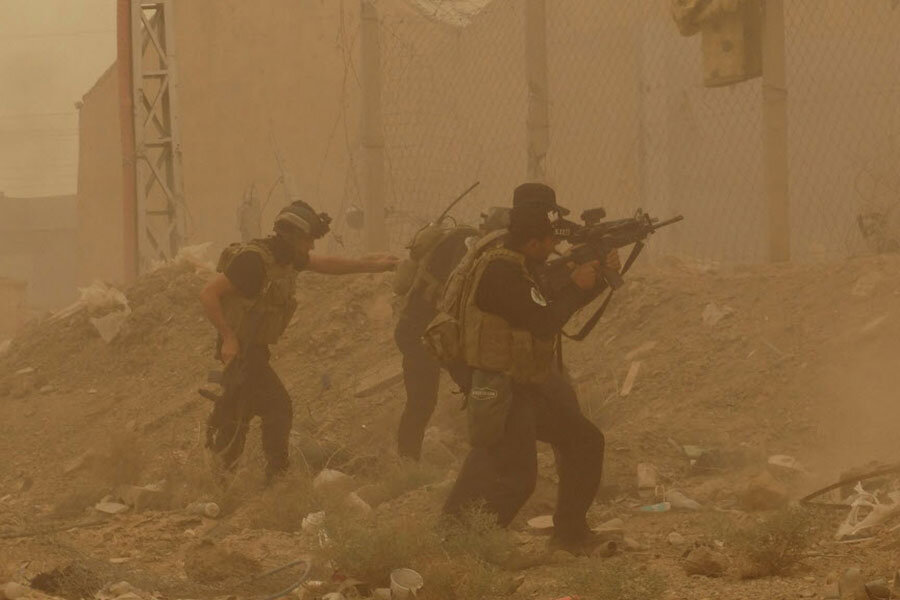Islamic State on the march? What fall of Ramadi tells us.
Loading...
No sooner had Ramadi fallen into the hands of the Islamic State than the drumbeat began.
The Islamic State was on the doorstep of Baghdad.
Iraqi forces were in disgrace, showing "no will to fight," United States Secretary of Defense Ash Carter told CNN Sunday.
The loss was "terribly significant," added Sen. John McCain (R) of Arizona to MSNBC, suggesting that "we'll have to have more people on the ground...."
In the fight to rid the Middle East of the Islamic State, last week was undoubtedly a step backward, with the doomsday Muslim pseudo-state also taking the historic town of Palmyra from Syrian government forces.
But a broader view suggests very little has changed. Indeed, at this point, the advance of the Islamic State appears to have less to do with the relentless expansion of a rigid and hateful ideology and more to do with the practical matter of tribal politics.
In Iraq, the United States' guns, money, and influence are long gone, while civil war has left much of Syria in chaos. In this power vacuum, Sunni tribesmen have in many cases leaned toward the Sunni-led Islamic State, fearing that Baghdad and Damascus are simply stooges for Shiite Iran.
"The myth is that there are radical Sunni tribes and moderate Sunni tribes. The tribes are not moderate or radical. Tribes hedge and look for the strongest power," Kuwaiti journalist Hussain Abdul-Hussain, who has close ties to Sunni tribes in the region, told Newsweek last year.
This leaves a fairly well-defined space where the Islamic State can operate and expand: Sunni areas in the Middle East where the government is weak and seen as being anti-Sunni. In other words, for now, western Iraq and eastern Syria.
On some level, the Islamic State advances in those areas is a "sorting" along sectarian lines as Sunnis in Iraq and Syria turn to an authority they see as more responsive and reflective of their own desires. By contrast, the Islamic State (also known as ISIS) has suffered setbacks in areas on the fringes of the Sunni heartland, such as Kobane and Tikrit.
"ISIS overextended itself and is getting pushed back to areas where they can control more effectively," Brian Fishman, a counterterrorism analyst at the New America Foundation, told The New York Times. "The historical homeland for this organization is Falluja, Ramadi, Anbar and Mosul."
In some respects, this presents a blueprint for how to constrict the space available to the Islamic State. Seven years ago, the US military helped drive a "Sunni Awakening" that significantly undermined Al Qaeda authority in Sunni areas of Iraq. Back then, it was the "strongest power," in Mr. Abdul-Hussain's words, and acted to woo and focus Sunni tribes against the atrocities of Al Qaeda.
Today, the atrocities are, if anything, worse. But to many Sunnis, the fear of Shiite militias in alliance with Baghdad or Damascus is worse still. Seeking strength and protection, many Sunnis see the Islamic State as the better option.
"I have always said I would much prefer to be killed by a Sunni terrorist organization than a Shiite terrorist organization," one Sunni tribesman in Iraq told The Wall Street Journal.
This sorting of Iraq and Syria into Sunni and Shiite power structures is a product of failed governments. Despite President Obama's promptings, the Iraqi government has become strongly sectarian, largely abandoning the promises that the US made to Sunnis and instead serving the country's Shiite minority. Meanwhile, the government of Syrian President Bashar al-Assad, an Alawite, has lost control over large swaths of the Sunni-majority country.
With both governments weak and the product of sectarian division, outreach to Sunnis seems a nonstarter.
"The only solution for the situation now is national reconciliation governments in both countries, Iraq and Syria, which is impossible now," Jalal Zein al-Din, a Syrian journalist, told the Times. "So IS is going to remain in the region, a state from Raqqa to Mosul."
It is the same situation faced by Afghanistan at the dawn of Taliban rule, suggests Borhan Osman, an analyst for the Afghanistan Analysts Network in Kabul, in an essay for Al Jazeera. In 1979, the Soviet invasion had toppled the Afghan government. After the Soviets left in 1989, the country was ruled by the mujahideen who had fought the Soviets – a period of civil war and ethnic strife that ended only with the arrival of the Taliban in 1996.
"Iraq now appears to be at the same point as when the Taliban – like the Islamic State today in Iraq – rose against the corrupt and powerless government of the mujahideen whose warlords and commanders had regularly oppressed the population," Mr. Osman writes.
Over time, he notes, Afghanistan's convulsions gradually grew less deadly, even though deaths under the Taliban drew more attention.
"For example, more than 25,000 people were reportedly killed in a single event in the Herat uprising in 1979. For the past 13 years, the conflict has killed between 50,000 and 60,000 people. By contrast, Iraq's death toll has reached well over 200,000 people since the US invasion in 2003, according to the Costs of War project," he writes.
Iraq presents a more difficult problem, Osman argues, since the ethnic tensions or Afghanistan are not as potent as Iraq's sectarian divides. But in Afghanistan, government has become one important agent of a nascent sense of unity, he adds:
In this sense, if the Taliban try an offensive, the general Afghan population will not see them as saviours from chaos once again and will not concede to their rule. In fact, most indicators point in the other direction. Afghanistan has seen a significant socio-economic and political transformation since the 1990s: an improved economy, growing urbanisation, improved governance, and greater access to health care, schools and universities for the general population.






